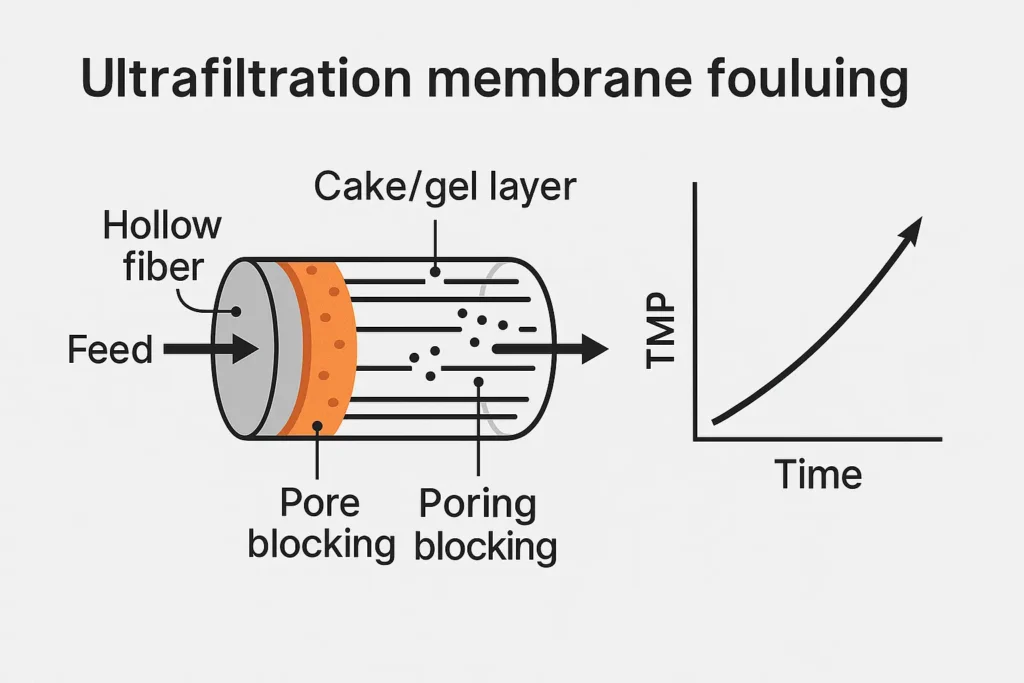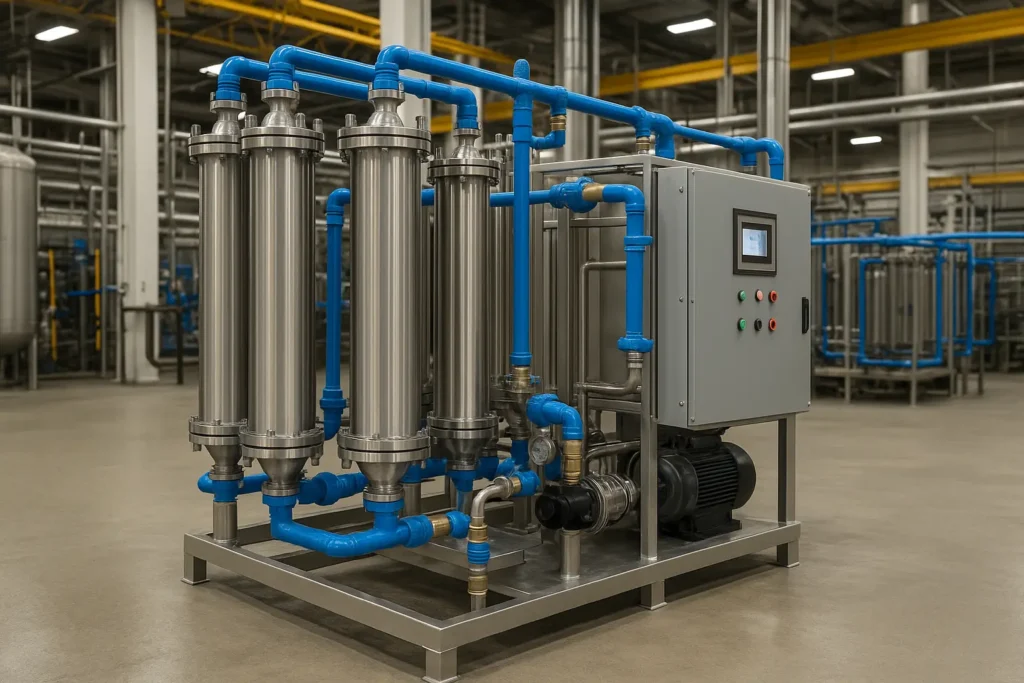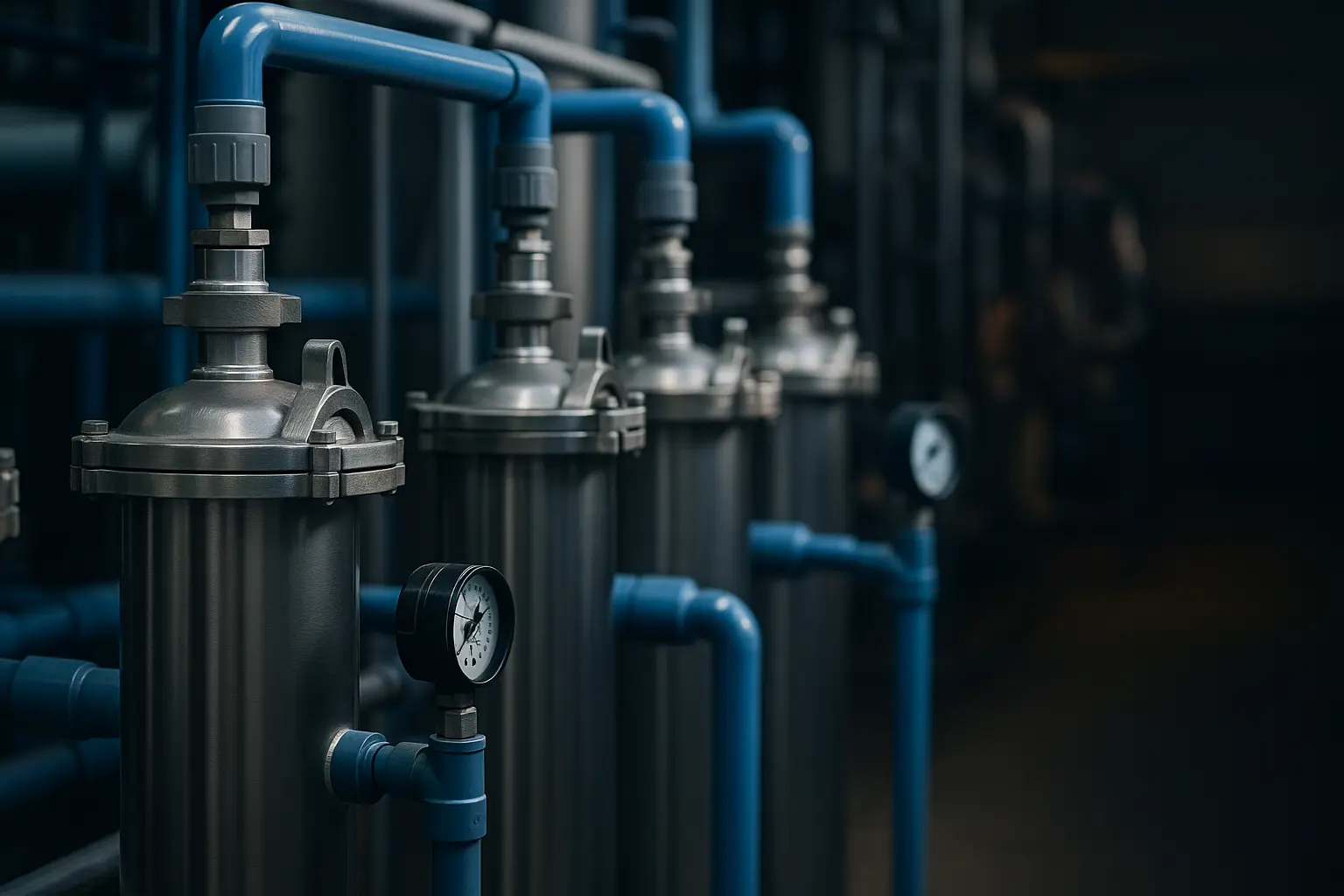This hands-on guide explains pengotoran membran ultrafiltrasi, how to diagnose it fast, and how to recover performance without risking downstream RO. You’ll find symptom maps, a recovery playbook, a prevention program, printable checklists, and FAQs engineers can act on.

Focus process:
UF dead-end & crossflow trains
You’ll learn:
12 root causes → recovery → prevention
Who is it for:
Plant engineers, O&M teams, integrators
Tip: Your Table of Contents plugin will auto-build from the H2/H3 headings below.
1) Snapshot: symptoms & fast triage
| Gejala | What it usually means | First checks (10–15 min) |
|---|---|---|
| Flux decline at same feed | Cake/gel layer growth; temperature drop; instrument drift | Normalize to 25 °C; verify flow & TMP sensors; review last 24 h turbidity/SDI |
| TMP rise by stage | Colloids, biofilm or scale; backwash/CIP cadence too low | Check backwash logs, air scour function, and chemical inventory/strength |
| Filtrate quality drift | Integrity loss or channeling | Run integrity/pressure hold test; inspect vents for air binding |
| Frequent alarms after CIP | Residual chemical release (“sponge effect”) | Rinse and neutralize to spec; confirm zero oxidant before RO |
Safety first: De-pressurize, lockout/tagout pumps, wear PPE, follow the membrane OEM chemical limits, and verify zero oxidant before sending filtrate to RO.
2) What UF is & where fouling happens
Ultrafiltration separates colloids and microorganisms while allowing salts to pass. In a modern plant the UF stage typically sits sebelum RO/EDI to stabilize SDI/turbidity or setelah clarification/polishing in food & beverage. Fouling forms on the fiber surface (cake/gel layer), within the pores (pore blocking), or as biofilm when nutrients and warm temperatures align.
3) Ultrafiltration membrane fouling — 12 likely root causes
Water & chemistry
- Low feed temperature → higher viscosity, lower flux at same TMP.
- High SDI/colloids or shock loads from pretreatment upsets.
- Algae/microbial spikes from warm raw water or long residence times.
- Chemical carry-over (coagulants, polymer, oxidants) binding on fibers.
Hydraulics & operations
- Overfeed flow/pressure trying to “chase production.”
- Insufficient crossflow velocity or air scour effectiveness.
- Backwash/CIP intervals too long for the load; skipped soaks.
- Incomplete post-CIP rinsing; pH not neutral when restarting.
Hardware & integrity
- Damaged elements, partial fiber breaks, or poor potting repairs.
- Air binding from bad vents causing localized dryness and scale.
- Instrumentation drift (flow, pressure, turbidity) hiding true TMP/flux.
- Strainers/guards missing or overloaded, letting debris reach modules.

4) Downstream impact (why UF fouling hurts RO & polishing)
- RO stress: SDI creep pushes RO into faster fouling cycles and higher OPEX.
- Chemical shock: retained NaOH/NaOCl can oxidize polyamide if not rinsed to non-detect.
- Quality variability: sporadic fiber leaks cause microbiological risk downstream.
5) Recovery playbook (gentle → aggressive)
Step A — Physical cleaning
- Optimize forward flush and backwash timing; confirm valves and sequences.
- Air scour where supported; verify blower delivery and distribution.
- Reset to OEM-recommended flux (critical flux margin) before chemistry.
Step B — Chemical cleaning (CIP)
- Alkaline clean for organics/biofilm: NaOH with surfactant; optional low-dose NaOCl if OEM allows.
- Acid clean for inorganics/scale: citric or other approved acid with anti-scalant dispersant.
- Method: recirculate 20–40 min → soak 10–30 min → recirculate → thorough rinse to neutral pH & zero oxidant.
Step C — Escalate when TMP isn’t restored
- Repeat targeted chemistry; extend soak; raise temperature within OEM limits.
- Rotate elements or replace modules that no longer recover.
6) Operating mode & design notes: dead-end vs crossflow
| Mode | Kelebihan | Watch-outs for fouling |
|---|---|---|
| Dead-end | Simpler, lower pumping energy | Higher fouling tendency; needs tighter pretreatment and more frequent backwash/CIP |
| Crossflow | Surface shear lowers cake buildup; steadier TMP | Higher recirculation energy; design for velocity windows and CFD-informed manifolds |
7) Integrity management: dealing with hollow-fiber breaks
If integrity tests fail or filtrate quality drifts, isolate the suspect train, plug identified fibers per OEM practice, then re-test. When the percentage of plugged fibers approaches the OEM limit, plan module replacement to avoid hidden bypass and persistent pengotoran membran ultrafiltrasi.
8) Monitoring & control checklist
| Interval | What to record | Why it matters |
|---|---|---|
| Every shift | Feed temp, turbidity/SDI, filtrate quality, feed/retentate/filtrate flows, TMP by stage | Builds a baseline to detect early fouling |
| Daily | Backwash/air scour success and durations; chemical inventory | Prevents spacing out cleans |
| Weekly | Integrity test, sensor calibration check, vent/strainer inspection | Validates true performance |
9) Prevention program (what “good” looks like)
- Keep velocity within design windows; avoid running at maximum TMP for long periods.
- Set alarm bands for TMP rise rate and filtrate turbidity; trigger clean/soak automatically.
- Jar tests each season change; track raw-water biology and switch chemistry accordingly.
- Spare parts: seals, strainers, gauges, oxidant/pH test kits, and at least one spare module per skid.
10) Quick BOM & spares list
- Hollow-fiber UF modules (per OEM code), O-rings/seals, strainers/guard filters
- CIP chemicals: alkaline (NaOH + surfactant), acid (citric or approved), neutralizers
- Oxidant, ORP and pH strips/meters; turbidity & SDI kits; calibration liquids
11) FAQs
What does a rising TMP mean?
It signals resistance at the membrane interface or inside pores. Trend TMP at constant temperature and normalized flux to confirm pengotoran membran ultrafiltrasi versus instrumentation drift.
How do I pick acid vs. alkaline cleaning?
Start with a short alkaline clean for organics/biofilm. If TMP is still high, follow with an approved acid clean for scale. Always rinse to neutral pH and zero oxidant before sending filtrate to RO.
How often should I clean?
Use trend-based intervals. Many plants backwash every 20–60 minutes and perform a short CIP every 8–24 hours of operation, tightening cadence during high-load seasons.
Can I run oxidant through UF?
Only under OEM-approved concentration, pH and temperature limits. Residual oxidant must be non-detect before permeate is allowed to reach RO to avoid polyamide damage.
12) Next steps (RFQ & helpful links)
Share your feed analysis and demand curve—our team will size velocity windows, backwash/CIP cadence, and recommend hygienic tanks & piping for reliable UF performance.
Internal resources: UF cleaning & maintenance - RO troubleshooting guide - DI water storage tank & loop design - Tangki & rumah baja tahan karat
Referensi eksternal: Water Quality Association - US EPA Water Research
Penulis: Stark Water Process Engineering Team (process design, O&M, commissioning). Peer-reviewed by: QA/Compliance. Last updated: 20 Oct 2025.
This guide is for trained professionals. Always follow your membrane OEM limits and site safety procedures.

